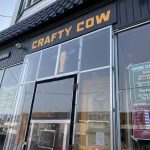2008
Have a heart
Maxie’s Southern Comfort 6732 W. Fairview Avenue 414-292-3969 maxies.com Save yourself a trip to N’awlins: Take I94 to 68th. Head north one block north and pull into Maxie’s Southern Comfort. With snow piled high as corn in July, Maxie’s is a hot spot that has already been discovered after eight months in business. Executive Chef Joe Muench puts the South in yo’ mouth with every bite of Southern specialty from barbecued shrimp and ribs to fried green tomatoes and succotash to blackened catfish. Is it any different from what you’d have south of the Mason-Dixon? Yes: it’s a whole lot better here. Muench opened Maxie’s for owners Dan Sidner and Chick Evens as a sister bistro to Evens’ Maxie’s Supper Club in Ithaca, New York. Their broad take on Southern cookery is reflected in the French, Spanish, German and African accents to the cuisine. The atmosphere is warmed with cayenne-colored walls, sparkling little chandeliers and red drapes roped together with massive gold tassels. The chef’s diverse culinary education and experience is evident on every plate. A notable special: the large grilled scallops served over sweet potato hash with frisee lettuce and a poached egg that bursts open to enrich the light butter sauce is mighty fine for anybody hankering to “grab a root” (have dinner). The suggested wine pairing is a rich, smoky pinot noir that tangles nicely on the taste buds with the hickory bacon in the hash. Just as enticing are the seared tenderloin filets drenched in a bourbon glaze, with barely steamed fresh spinach and crunchy corn succotash. Though the chef personally eschews fried food, the creamy potato croquettes and the lacey onion rings are evidence that he’s mastered the art. Using them as accents rather than focal points keeps the diner out of the heart attack zone. Slow your pulse even more with a Scarlet O’Hara, a tot of Southern Comfort, cranberry juice and bitters that, like its namesake, is sweet, sassy and surprisingly potent. Chef Muench learned his trade right here in Milwaukee, starting at his grandmother’s table. “How many kids come home to boiled heart for dinner?” he wants to know. “My grandmother lived with us for six years and it was like Thanksgiving every day. She made bread, applesauce and rhubarb and we ate a lot of unconventional foods like oxtail soup, beef tongue and liver and onions. Coming through the hardships of war, she used everything. That exposure piqued my interest in cooking: helping her, watching her and just eating.” Though Muench has never lived or worked outside the state, family visits to Louisiana gave him a bank of food memories to tap in his current employment. “Southern cooking was always on my radar. Southern has the largest cumulative style – barbecue to game to fish.” Muench tried college but was impatient with the pace. MATC’s culinary arts program gave him the opportunity to work in his field while he was getting his degree. “I could see the rewards of working sooner. […]
Jan 1st, 2008 by Cate MillerA part of the solution
In the auditorium of the John C. Cudahy YMCA, the basketball hoop blocks the view of the stage. Kendall tells the lanky teens shooting hoops to go upstairs for a while so Scott can set up his tripods, flashes and umbrellas. This is the only YMCA in the country built specifically to accommodate the arts. Set on 55 acres of wooded land – formerly John C. Cudahy’s farmstead – and home to a “safe place” where teens can study, use computers and play sports and video games, it’s a far cry from the popular image of the Y as a fitness club, a place to play racquetball and run laps on the track. Kendall Hayes, now 20, joined AmeriCorps right out of high school. He’d been working so many hours at the branch’s front desk as part of STEP-UP (a career development program for high school students run by the county’s Private Industry Council) that a friend suggested he might as well earn volunteer hours and collect an education award as a full-fledged AmeriCorps member. Now he’s in his second year of service at the YMCA, where he helps students in the teen program with everything from homework and test preparation to setting up bank accounts and working creatively. “[I try] to get kids to stay active, to get them to expand their horizons and open them up to new things,” he says, “not just coming here to play basketball every day, but getting them to do something artsy, or getting them to go back and help their community.” Right now, Kendall is working on developing an art guild for the teens that would incorporate creative writing, music and visual art. AmeriCorps members can serve a maximum of two terms and qualify for the education award, and when his term is up, Kendall plans to go to the University of Wisconsin-Milwaukee, maybe to study recording arts and psychology. “I’m the type of person that likes to do everything, [and] AmeriCorps has offered new possibilities for me … We’ve [done everything from] helping inner city youth to working on Philadelphia Community Farm to disaster relief training,” he says. “[But] going back to school is a whole different section of my life.” Still, he says, “I do wish that I could stay longer. There’re a lot of different opportunities and I don’t feel that I’ve experienced it all. And I’m always willing to lend a helping hand.” Kendall’s commitment to public service is unadorned, stunningly simple. In our interview, he speaks gracefully about what service can do for communities – and what community service gives to those who serve. The organization In 1993, then-President Bill Clinton established AmeriCorps as the country’s flagship service initiative. It’s often assumed to be a single program, like the domestic version of the PeaceCorps, but AmeriCorps is actually a network of organizations, a bear hug that encompasses four primary programs: AmeriCorps*State and AmeriCorps*National, which provide funding and volunteer resources to statewide and national organizations; the National Civilian […]
Jan 1st, 2008 by Amy ElliottPat Graham
Music and media pop and move. We are digital and online. Genres slide into each other, constantly bounding forward. That’s why Pat Graham’s new photography book, Silent Pictures, is so important: it’s an anchor to link us to the past. Silent Pictures is his first book, showcasing underground rock at its finest through the past two decades. The collection features bands as diverse as Modest Mouse, Outkast, Elliot Smith, Fugazi, Thievery Corporation, Built To Spill and The Shins, on the road and backstage, in a mode that is raw, dirty, lonely, triumphant, gritty and real. Graham, a Milwaukee native, spoke to VITAL from his London gallery, 96 Gillespie, to discuss Silent Pictures, being on the road with Modest Mouse and future projects. For more information, visit 96gillespie.com or modestmouse.com/photoblog. Define Silent Pictures – what’s its attitude? It’s a photography book, plain and simple. It’s about the images, and hopefully it’ll help expose the road life of bands. We put a lot of thought into the editing, assembling the book like a record to balance quiet and explosive moments. We want to grab attention and get people to stop flipping, to really engage them and get them to inspect interesting photos. With digital photos, we flip to quick. With this book, we want you to stop in your tracks. Describe your evolution as a photographer in the rock world. I was born in Milwaukee and kicked around a bit. I started shooting photos at Café Voltaire in Milwaukee around age 17 and studied photography at UWM. Soon after school, I moved to Washington DC. I had a friend that was in bands out there. That’s what kickstarted my photography at shows. I really got into the scene. Shot a lot of Fugazi in ‘91-‘92. It was around that time I started touring with Modest Mouse. It was me with the three guys and a van. It was bare bones, man. I’d do merch, drive a lot, move gear in and out of shows; shooting the whole time. I still tour with them regularly and post photos on their tour blog. I’ve also had the good fortune to have work printed in major European and U.S. music publications like Rolling Stone. What is your greatest accomplishment as an artist? Doing exhibitions with my wife Melanie Standage – it’s the process of setting them up and seeing things on the wall. Our shows “Past Perfect” or “Wildebeest” were fun to do. The book is a great thing to do and have done but there’s something about showcasing the real prints that always exciting. Also, the Experience Music Project in Seattle purchased a number of my prints for their collection which is a great feeling, too. What’s up in the UK? I founded 96 Gillespie with my wife. It’s a London gallery that features a lot of American artists. It’s a place to start a dialogue between UK and US artists. Describe your evolution as a photographer in the rock music world. Where do […]
Jan 1st, 2008 by Howie GoldklangThe road goes on forever
As work on the Marquette interchange reconstruction project nears completion, I find myself impressed by the enormity of the project as well as with the relative lack of inconvenience it’s caused. Sure, there were occasional delays, as well as closed exits and lanes that added minutes to commutes, but overall, the level of congestion and other problems never seemed to exceed tolerable levels. After all, if you choose to live in an urban area, a certain degree of crowding and waiting is part of life. In a way, it’s too bad. Anyone who feels that we are overreliant on the automobile knows that the only time most people will consider alternative options to driving is when there are significant costs associated with cars. In other words: no pain, no gain. Of course, Americans are notoriously attached to their cars. Even skyrocketing gas prices don’t seem to make a dent in our dependence on the automobile. Here in Milwaukee, we are fortunate to have it pretty easy when it comes to getting around. Driving from one side of town to the other rarely seems to take more than twenty minutes. The rush hour traffic reports usually sound like we live in some kind of Pleasantville with clear roads and minimal delays. People who grumble about traffic or the cost of parking clearly haven’t traveled much. Drivers in Chicago, New York and Boston face extreme traffic congestion, as well as expensive parking costs that encourage alternatives. Not surprisingly, all three cities have extensive subway systems. The one place where there is gridlock here in Southeastern Wisconsin is on the road to funding new or expanded mass transit options. The proposed extension of Chicago’s Metra system from its terminus in Kenosha to Racine and Milwaukee, known as the KRM line, gets a lot of support – that is, until the subject of dedicated local funding comes up. Under pressure The proposed increase in the tax on rental cars to support the KRM didn’t survive the state budget, leaving advocates for the line hoping they can build support for a referendum on a regional sales tax increase. Good luck with that. In addition, Milwaukee Mayor Tom Barrett and County Executive Scott Walker are at odds over proposals to improve the local transit system, continuing an impasse that goes back more than ten years and leaves about $100 million in federal funding on the table. Sigh. It’s yet another example of a pressing public issue crying out for leadership and regional cooperation. Which brings us back to the Marquette interchange project and the efficient, though costly, road construction program. Why is it that road construction barrels on while so many other needs struggle for funds? To adapt a popular bumper sticker, perhaps one day schools will have dedicated funding and road planners will hold bake sales. But that won’t happen anytime soon. With the Marquette project wrapping up, the state has ambitious plans to expand Interstate 94 down to the Illinois border at a cost […]
Jan 1st, 2008 by Ted Bobrow





















